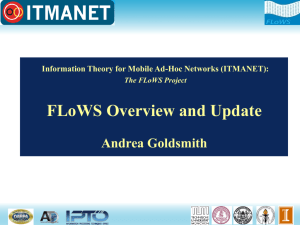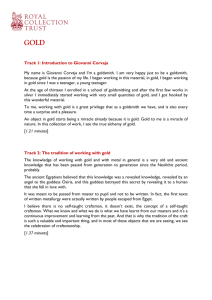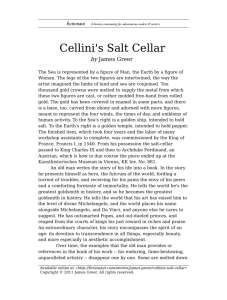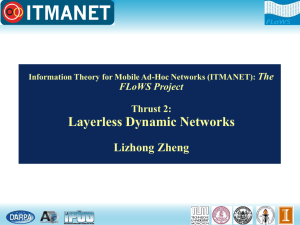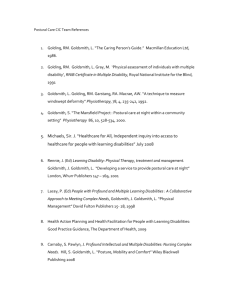Goldsmith
advertisement
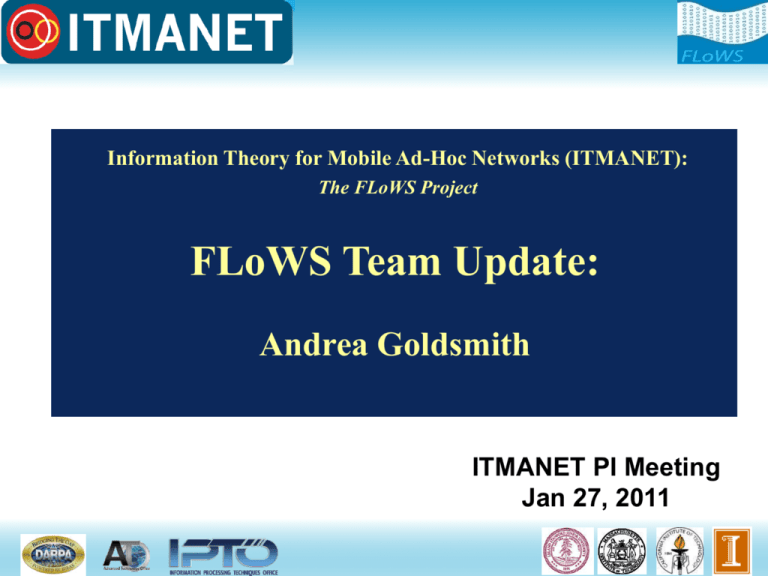
Information Theory for Mobile Ad-Hoc Networks (ITMANET): The FLoWS Project FLoWS Team Update: Andrea Goldsmith ITMANET PI Meeting Jan 27, 2011 New Theory and Insights Key New Theory and Insights • Thrust 0 – New definitions of reliable communications in the face of uncertainty – Performance over finite time windows • Thrust 1 – Network Equivalence – Network Coding in Noise/Loss – Multiterminal Strong Converses • Thrust 2 – Layered and structured codes – Control/capacity connections for time-varying channels with noisy and/or rateconstrained feedback – Generalized capacity and separation • Thrust 3 – – – – • Stochastic Multi-period Network Utility Maximization Relaxation and distributed techniques for network optimization Mean Field Equilibrium for Stochastic games Learning in dynamic environments Interthrust – – – – Coordination via Communication Relaying, cooperation and cognition Network coding Capacity regions for more than 3 users Recent Accomplishments Thrust 0 Recent Achievements Models Coleman, Effros, Goldsmith, Medard, Zheng: Channels and Networks with Feedback Effros: networks with side information Cover: Coordinated Networks Moulin: Mobility El Gamal: More than 3 users Goldsmith: Cognitive Nodes Medard, Zheng: Distortion-Outage tradeoff Effros, Goldsmith: Expectation and Outage in Capacity and Distortion Zheng: UEP Goldsmith: Diversity/multiplexing/delay tradeoffs Medard: delay/energy minimization Shah: multicast capacity Metrics Medard: Stability Regions Thrust 1 Recent Achievements Goldsmith: multi-way relay channel Goldsmith: multicasting with a relay Medard: effect of coding versus routing El Gamal: Noisy network coding Effros: continuity of network coding regions New bounding techniques Effros: linear code construction Code construction Network information theory Goldsmith: joint source-channel coding with limited feedback Goldsmith: capacity and interference rates for the interference channel Effros: Network equivalence Cover : Capacity of coordinated actions Zheng, Medard : distortion-outage tradeoff Metrics Koetter, Medard: On the stability region of networks with instantaneous decoding Cover: Martingale lattices Combinatorial Tools Networking and optimization Thrust 2 Recent Achievements Dynamic Network Information Theory El Gamal: Noisy Network Coding Goldsmith: Multicast with relay; BC with cognitive relay Shah: Positive Recurrent Medium Access Effros: distributed network coding with coded side information Moulin: exploiting mobility of relay networks Cover: coordination capacity Moulin: finite-blocklength codes Effros: linear representation of network coding Coleman: Control principle for feedback channels Medard, Zheng: Diversity-distortion tradeoff Goldsmith: Joint source channel coding / outage Zheng: tilted matching for feedback channels Medard, Goldsmith: Wireless network coding Effros: two stage polar codes CSI, feedback, and robustness Zheng: Instantaneous Efficiency Structured coding Thrust 3 Recent Achievements Boyd, Goldsmith: Wireless network utility maximization as stochastic control Boyd: Distributed optimization El Gamal: Overhead in distributed algorithms Shah: Distributed MAC using queue based feedback Optimization Distributed and dynamic algorithms for resource allocation Ozdaglar: Distributed second order methods for network optimization Ozdaglar: State-dependent distributed optimization Medard: Decoding and network scheduling for increased capacity Ozdaglar: Noncooperative power control using potential games Johari: Large network games Ozdaglar: Near potential games for network analysis Meyn: Q-learning for network optimization Johari: Supermodular games Johari: Mean field equilibrium Effros: Noncooperative network coding Stochastic Network Analysis Flow-based models and queuing dynamics Game Theory New resource allocation paradigm that focuses on hetereogeneity and competition Publications to date • 5 books or book chapters; 1 more under development • 46 published/accepted journal papers, 28 submitted • 169 conference papers (published or to appear) • SciAM paper appeared • Comm. Magazine paper to appear this month • Publications website: – http://www.stanford.edu/~adlakha/ITMANET/flows_publications.htm Phase 4 Progress Criteria – Demonstrate the consummated union between information theory, networks, and control; and why all three are necessary ingredients in this union. – Write a monograph to be published by NOW jointly in Foundations and Trends in Information Theory and in Foundations and Trends in Networks on our new information theory for MANETs. Also publish a shorter version in IEEE Proceedings. – Use our results to provide challenges and solutions for the broader community that designs and builds MANETs Work Products (possibly merged with Nequit) How to maximize ITMANET impact • Community Website – “go-to” website for network information theory – Merging of two current websites, with hooks? – Get feedback at ITA • IEEE Proceedings special issue – Survey paper on FLoWS results and conclusions – Invited papers on all major topics within/between thrust areas • Survey paper – Part of Proceedings Special Issue • Tutorials and Short Courses – (for web and IT school) – In each thrust area/across thrust areas – Link to website • Position paper about follow-on programs (ITMANET 2.0) – DC Govt/Industry Day for our last meeting Transitions via DC Day • Transition to other DARPA programs • Transition to and synergies with other government research programs • Transitions to and synergies with corporate research programs/investments Tech Transfer • Standards • Patents • Company Workshops • Commercial Transfer
